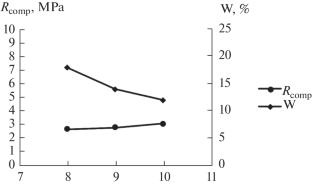基于含硅技术原材料的无机热泡沫硅酸盐陶瓷材料
IF 0.5
Q4 MATERIALS SCIENCE, MULTIDISCIPLINARY
引用次数: 0
摘要
摘要--研究并证实了利用技术和天然原料合成无机热泡沫硅酸盐玻璃化材料的可能性。研究人员选择了获得优质产品的成分和模式。在微硅石和霞石浓缩物的基础上,添加白垩和石膏,合成了密度为 0.49-0.52 g/cm3、强度为 2.7-3.10 MPa、热导率为 0.059-0.062 W/(mK)、吸水率为 12-18% 的热泡沫硅酸盐。本文章由计算机程序翻译,如有差异,请以英文原文为准。


Inorganic Thermofoam Silicate Vitrified Materials Based on Silica-Containing Technogenic Raw Materials
Abstract—The possibility of synthesizing inorganic thermofoam silicate vitrified materials from technogenic and natural raw materials has been studied and substantiated. Compositions and modes for obtaining quality products have been selected. On the basis of microsilica and nepheline concentrate with the addition of chalk and gypsum, thermofoam silicates with a density of 0.49–0.52 g/cm3, a strength of 2.7–3.10 MPa, a reduced thermal conductivity of 0.059–0.062 W/(m K), and a water absorption of 12–18% have been synthesized.
求助全文
通过发布文献求助,成功后即可免费获取论文全文。
去求助
来源期刊

Inorganic Materials: Applied Research
Engineering-Engineering (all)
CiteScore
0.90
自引率
0.00%
发文量
199
期刊介绍:
Inorganic Materials: Applied Research contains translations of research articles devoted to applied aspects of inorganic materials. Best articles are selected from four Russian periodicals: Materialovedenie, Perspektivnye Materialy, Fizika i Khimiya Obrabotki Materialov, and Voprosy Materialovedeniya and translated into English. The journal reports recent achievements in materials science: physical and chemical bases of materials science; effects of synergism in composite materials; computer simulations; creation of new materials (including carbon-based materials and ceramics, semiconductors, superconductors, composite materials, polymers, materials for nuclear engineering, materials for aircraft and space engineering, materials for quantum electronics, materials for electronics and optoelectronics, materials for nuclear and thermonuclear power engineering, radiation-hardened materials, materials for use in medicine, etc.); analytical techniques; structure–property relationships; nanostructures and nanotechnologies; advanced technologies; use of hydrogen in structural materials; and economic and environmental issues. The journal also considers engineering issues of materials processing with plasma, high-gradient crystallization, laser technology, and ultrasonic technology. Currently the journal does not accept direct submissions, but submissions to one of the source journals is possible.
 求助内容:
求助内容: 应助结果提醒方式:
应助结果提醒方式:


